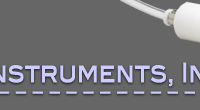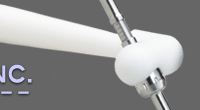|
How does the Pipetter sample powders?
The SDSII Powder Pipetter uses a precisely
metered vacuum to pull the powder into an adjustable variable volume
chamber, the pipette, where it is retained until aspirated by changing
the direction of the air flow with controlled air pressure. A filter/piston
connected to a metering rod and micrometer head provide very fine
and precise adjustment of the pipette volume.
What is the range of sample volumes that
can be pipetted?
The available standard pipettes come in
4l volumes and are infinitely adjustable from zero to the maximum
volume for the pipette size. Pipette
Volume Table
What types of powders can be successfully
pipetted?
A wide range of powders have been accurately
sampled and dispensed. The list includes but is not limited to:
-Powdered Metals -Plastics -Toners -Silica -Food and beverage powders
-Glass micro-spheres -Salts -Plastic Beads -Agricultural products
such as whole seeds, milled seeds and grains, fertilizers, etc.
Will the Powder Pipetter sample high moisture
content or slurries?
The Powder Pipetter can pipette powders
with a high moisture content. However, the moisture content will
have an effect on the accuracy and repeatability of the samples.
Slurries are not recommended.
What type of Air and vacuum source does the
Control Unit have?
The 2300A Control Unit is a complete, self
contained and portable system that is easy to set up and use. It
requires only a connection to AC power. It uses a reliable oil-less
compressor/Vacuum pump suitable for the laboratory environment.
- Long life, 5,000 hours typical
- Air and vacuum are controlled via foot switch to reduce operator
fatigue.
- Air pressure is adjustable from 0 - 15 PSI
- Vacuum is adjustable from 25 - 0 in. hg
- Air and Vacuum gauges are provided for ease and repeatability
of adjustment.
- All stainless steel housing
- A disposable air filter/water separator is provided to ensure
clean dry air to the pipette and eliminate cross contamination.
Do I need to use the Control Unit?
The 2300A Control Unit is a complete, self
contained and portable system that is easy to set up and use. It
requires only a connection to AC power.
Can I substitute my in house vacuum and air
supplies for the Control Unit?
It is possible to substitute"shop" or laboratory
air and vacuum sources, however, precise control of both air and
vacuum are key to uniform powder samples.
How accurate are the samples I can expect?
A micrometer type head with a very fine
thread is used to provide very fine adjustment of the size of the
material to be sampled. The typical sample size will vary less than
+/-1 1/2 % To a certain extent, controlling the tap density of the
powder during pipetting will reduce the sample variation.
How repeatable are the adjustments?
The micrometer head is marked and calibrated
making resetting the Pipetter easy and repeatable once the same
size and or weight has been determined and recorded. Under the typical
controlled conditions, repeatability will be within 1%
What type of filter is used in the Pipetter?
A depth type filter is the primary type
of filter used in the pipette to contain the powdered material in
the pipette. There are four standard sizes of pipettes and filters. Pipette
Volume Table
What is the filter material used in the Pipette?
The filter material is medical grade polymer,
UHMWPE (Ultra High Molecular Weight Polyethylene) or stainless steel.
Can the filters be cleaned and reused?
The polymer can be cleaned and reused in
certain conditions, using a suitable process. However, it is recommended
that the polymer filters be discarded when sampling different materials
to absolutely avoid cross contamination. Replacement filter cups
and elements can be purchased as support items.
How do I clean the polymer type filters?
The polymer dept filters can be cleaned
using most common cleaning processes such as common solvents, D.I.
water, mild acids and caustics, wet steam and autoclaving. The filter
elements must be completely free of moisture before reuse. A chart
of chemical compatibility should be consulted before attempting
to clean the filters.
Can the stainless steel filter cup and elements
be cleaned or reused?
The stainless steel filter cups may be cleaned
in a suitable cleaning agent consistent with the powder being sampled
before changing powders or reusing.
How do I clean the stainless steel frit type
Pipettes and filters?
The stainless steel Pipettes can be cleaned
using most common cleaning processes such as common solvents, D.I.
water, mild acids and caustics, wet steam and autoclaving. The filter
elements must be completely free of moisture before reuse.
How do I clean the Pipetter Handle and micrometer
head?
The Pipetter Handle and other parts may
also be cleaned using most common cleaning materials and processes
such as solvents, D.I. water, mild acids and caustics, wet steam
and autoclaving. The Air/Vacuum fitting is constructed of all stainless
steel and Poly-tetraflouride (Viton) seals and do not require disassembly
when cleaning the handle.
Are the O-rings reusable?
The seals are Poly-tetraflouride (Viton)
material and have excellent resistance to most cleaning solvents,
mild acids and caustics. The seals can be cleaned with the Handle
and reused. Prolonged exposure to superheated steam may degrade
the O-ring seal. It is recommended that the O-ring seal on the Filter
Cup be replaced each time the filter is cleaned as it may have changed
shape or damaged due to wear if the powder under test was abrasive.
This product is  marked. marked.
 We accept Visa and MasterCard We accept Visa and MasterCard
|







